Catapult Physics
Catapult physics is basically the use of stored energy to hurl a projectile (the payload), without the use of an explosive. The three primary energy storage mechanisms are tension, torsion, and gravity. The catapult has proven to be a very effective weapon during ancient times, capable of inflicting great damage. The main types of catapults used were the trebuchet, mangonel, onager, and ballista. These types of catapults will be described, and pictures and illustrations will be included.Catapult Physics – The Trebuchet
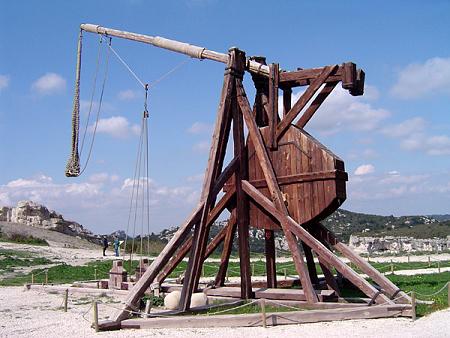
Source: http://en.wikipedia.org/wiki/Trebuchet. Author: ChrisO
A trebuchet is a battle machine used in ancient times to throw heavy payloads at enemies. The payload could be thrown a far distance and do considerable damage, either by smashing down walls or striking the enemy while inside their stronghold.
Among the various types of catapults, the trebuchet was the most accurate and among the most efficient in terms of transferring the stored energy to the projectile. In addition, it allowed greater consistency in the throws due to the fact that the same amount of energy could be delivered every time, by way of a raised counterweight.
A trebuchet works by using the energy of a falling (and hinged) counterweight to launch a projectile (the payload), using mechanical advantage to achieve a high launch speed. For maximum launch speed the counterweight must be much heavier than the payload, since this means that it will "fall" quickly.
The physics behind a trebuchet is fairly complex. A detailed explanation of it is given on the page on Trebuchet Physics.
In some designs a guide chute is used to guide the sling along and support the payload until the speed is great enough to hold it in the pouch alone.
The beginning of the launch is illustrated in the figure below.
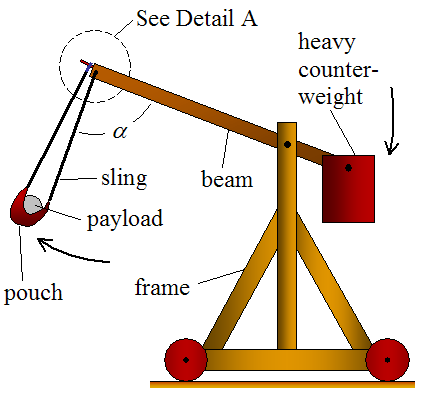
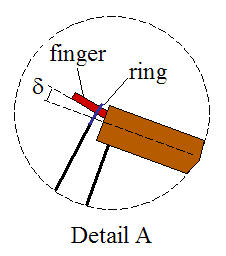
As you can see, the counterweight pivots around a much shorter distance than the payload end. The advantage of this is that the payload end of the beam reaches a much higher linear velocity than the counterweight end of the beam. This is the principle of mechanical advantage, and is what allows the payload to reach a high launch velocity. However, because the counterweight pivots around a much shorter distance, its weight must be much greater than the weight of the payload, to get a high launch velocity. However, increasing the mass of the counterweight beyond a certain point will not help, since the limiting speed of the falling counterweight is free-fall speed.
The sling releases when a certain angle α is reached. At this point the ring (which is connected to the sling and loops around the finger for support) slips off and the payload is launched. The release angle α can be adjusted by changing the finger angle δ. For a greater δ the release angle α increases. For a smaller δ the release angle α decreases.
The figure below illustrates the trebuchet at the release point.
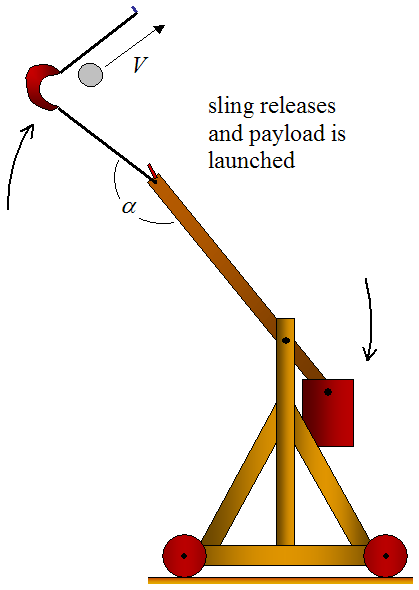
As the beam rotates clockwise (due to the falling counterweight), the payload experiences centripetal acceleration which causes it to move outwards (since it is unrestrained). This results in a large increase in linear velocity of the payload which far exceeds that of the end of the beam to which the sling is attached. This is the heart of the physics behind a trebuchet and is the reason why a trebuchet has such great launching power.
For a more in-depth explanation on how a trebuchet works see Trebuchet Physics. In this page the basic equations describing the physics of a trebuchet will be introduced.
To assist you in building a trebuchet you can use this simulator to help you come up with the design that throws the payload the farthest. This is very useful for helping you come up with the winning design in a trebuchet competition!
In the next section we will look at the mangonel.
Catapult Physics – The Mangonel
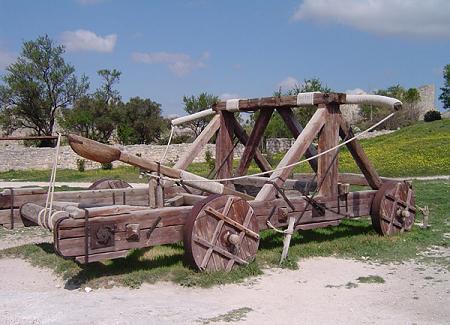
Source: http://en.wikipedia.org/wiki/Catapult. Author: ChrisO
The above picture of the mangonel is what people are most familiar with when they think of catapults. The mangonel consists of an arm with a bowl-shaped bucket attached to the end. In this bucket a payload is placed. Upon release, the arm rotates at a high speed and throws the payload out of the bucket, towards the target. The launch velocity of the payload is equal to the velocity of the arm at the bucket end. The launch angle of the payload is controlled by stopping the arm using a crossbar. This crossbar is positioned so as to stop the arm at the desired angle which results in the payload being launched out of the bucket at the desired launch angle. This crossbar can be padded to cushion the impact.
The mangonel was best suited for launching projectiles at lower angles to the horizontal, which was useful for destroying walls, as opposed to the trebuchet which was well suited for launching projectiles over walls.
However, the mangonel is not as energy efficient as the trebuchet for the main reason that the arm reaches a high speed during the launch. This means that a large percentage of the stored energy goes into accelerating the arm, which is energy wasted. This is unavoidable however, since the payload can only be launched at high speed if the arm is rotating at high speed. So the only way to waste as little energy as possible is to make the arm and bucket as light as possible, while still being strong enough to resist the forces experienced during launch.
The physics behind a mangonel is basically the use of an energy storage mechanism to rotate the arm. Unlike a trebuchet, this mechanism is more direct. It consists of either a tension device or a torsion device which is directly connected to the arm.
The figure below illustrates a mangonel in which the energy source is a bent cantilever, which is a form of tension device. This can consist of a flexible bow-shaped material, made of wood for example.
The point P in the figure is the pivot axle, attached to the frame, about which the arm rotates.
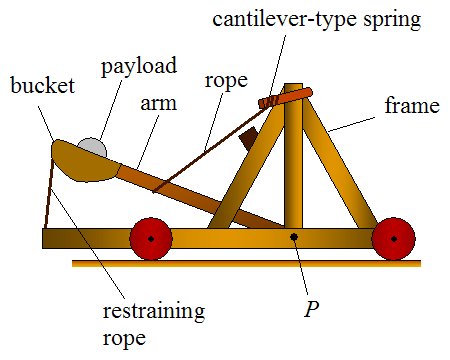
The figure below shows the mangonel at the launch point. To launch the payload the restraining rope is released.
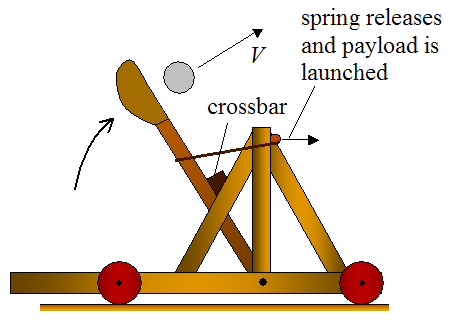
The other type of energy storage mechanism is a torsion device, which can consist of twisted rope. This allowed for greater throwing power than the tension device, in ancient catapults. The figure below illustrates the torsion device.
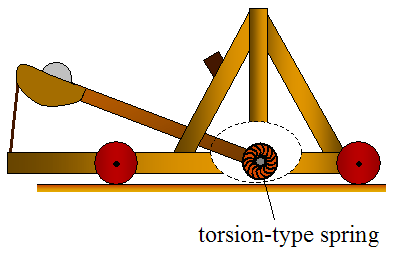
The twisted rope is commonly referred to as a torsion bundle. It consists of several lengths of rope with the arm inserted in between them. The rope is then twisted manually on both sides of the arm using levers. Upon release, the torsion bundle rotates the arm at high speed, launching the payload. The figure below illustrates how a torsion bundle is twisted.
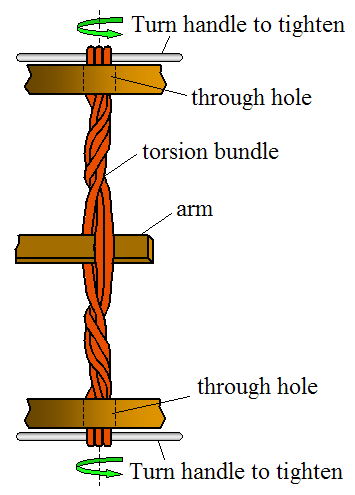
The video below shows how to wrap the rope on a torsion catapult.
The fact that a mangonel uses an energy storage device that consists of a deforming material, like wood or rope, means that its throwing distance will not be as consistent as a trebuchet. This is because these materials (unlike more modern materials), naturally wear and lose elasticity during their use. This is something that needs to be constantly monitored during a battle, with replacement materials made readily available, if necessary.
In the next section we will briefly discuss the onager.
Catapult Physics – The Onager
The onager catapult is almost identical to the trebuchet, but instead of a falling counterweight, it uses a torsion bundle to rotate the arm (similar to the mangonel, described previously). Because of its design, it allowed for greater throwing distance than the mangonel (comparable to that of a trebuchet). But the throwing distance wasn't as consistent as the trebuchet since it relied on deformable materials as the energy source, which naturally wear and lose elasticity during their use.
Lastly, we will look at the ballista.
Catapult Physics – The Ballista
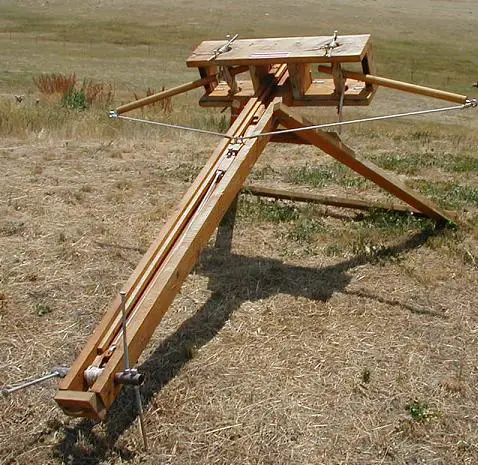
Source: http://en.wikipedia.org/wiki/Ballista. Author: Scigeek
The ballista is similar in principle to a crossbow, but much larger. Like the torsion powered mangonel, it used twisted rope as the energy source. The picture above shows the torsion mechanism consisting of twisted rope, located at the pivot location of the two side arms.
In the ballista, the bow string would be winched back and the tension set. It would be used to launch darts, bolts and spears with deadly force and accuracy. It could also be used to launch stone projectiles of various sizes.
Return to The Physics Of Battle page
Return to Real World Physics Problems home page
Free Newsletter
Subscribe to my free newsletter below. In it I explore physics ideas that seem like science fiction but could become reality in the distant future. I develop these ideas with the help of AI. I will send it out a few times a month.